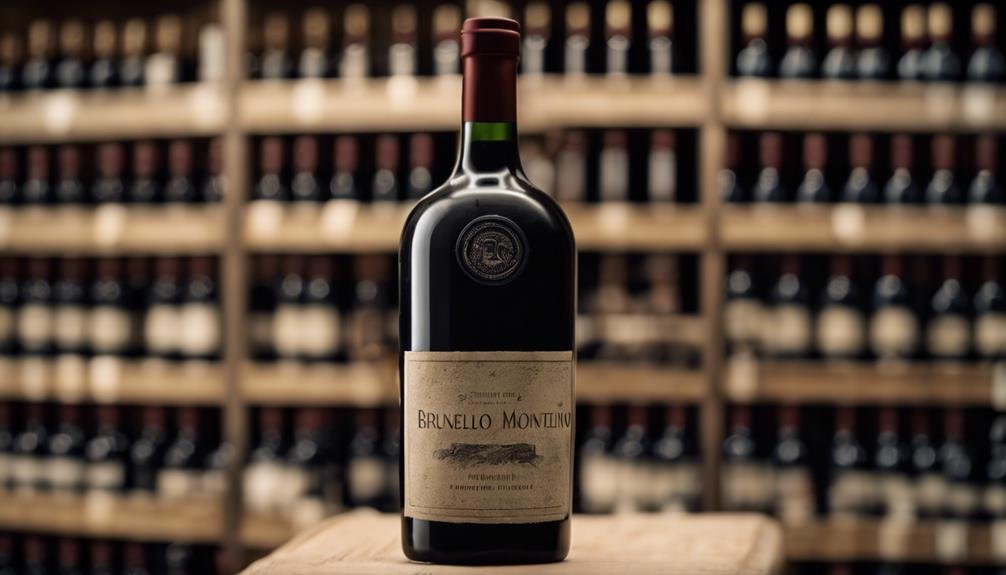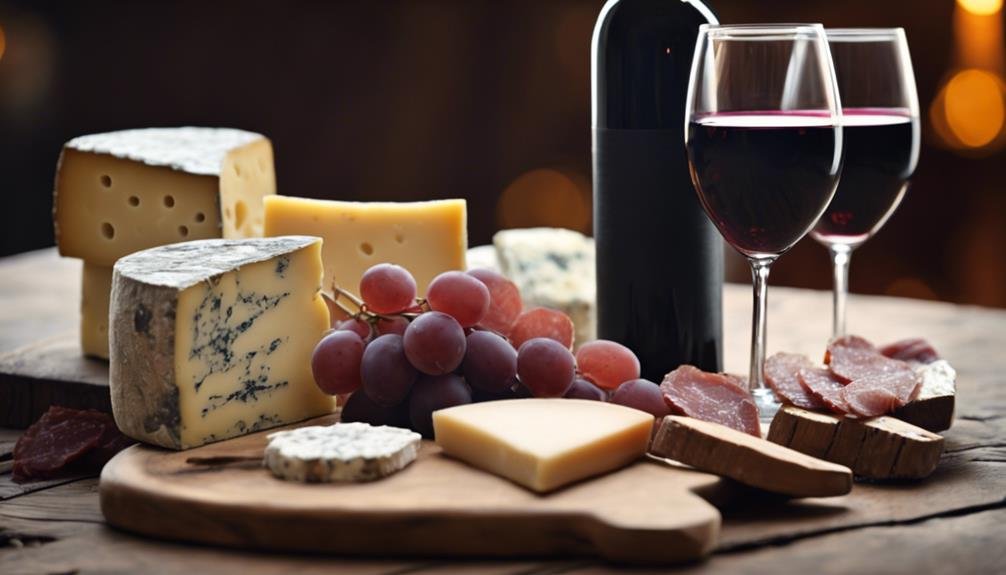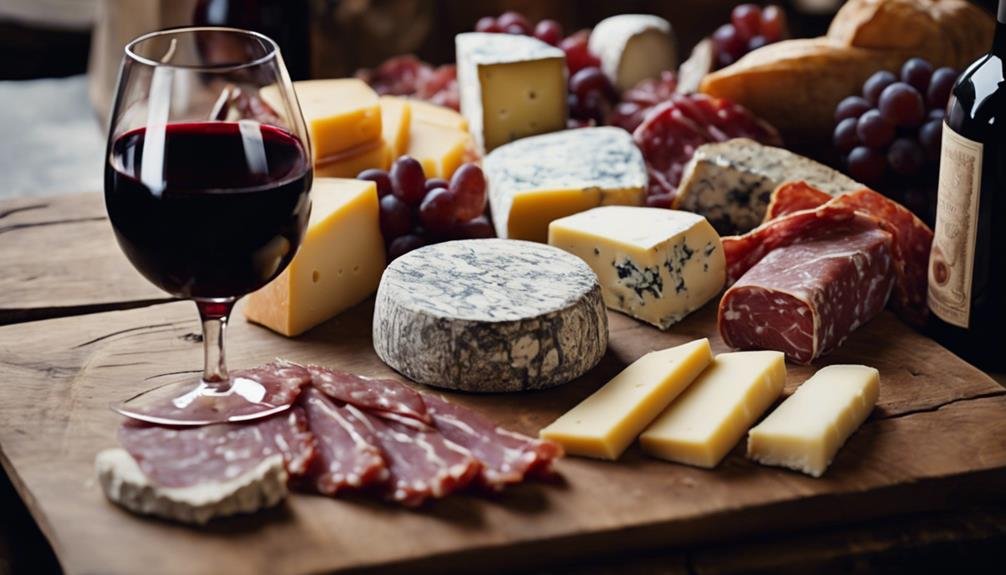Discover the essence of Brunello di Montalcino, a Tuscan gem made exclusively from Sangiovese grapes. Hand-harvested and aged in oak, it evolves from youthful fruity notes to rich chocolatey tannins with proper aging. Highly valued vintages like 2015 and 2010 command attention, attracting collectors globally. Traditional aging in Slavonian oak yields complex tertiary flavors, while modern French oak offers immediate gratification. Pair this wine with savory dishes like grilled ribeye steak or aged Pecorino cheese to elevate your dining experience. Unravel the layers of this exquisite wine and explore the art of aging to enhance your enjoyment.
Brunello Di Montalcino Production
Produced exclusively in the picturesque region of Tuscany, Italy, Brunello di Montalcino is crafted from 100% Sangiovese grapes, earning it the prestigious DOCG classification as one of Italy's finest wines.
The grapes used in Brunello are hand-harvested to guarantee quality. The wine undergoes fermentation in either stainless steel tanks or concrete to maintain the essence of the local Tuscan Sangiovese.
After fermentation, Brunello di Montalcino is aged in oak barrels, adding depth and complexity to the final product. This meticulous process results in a wine known for its bold fruit flavors, high tannins, and acidity, making it a favorite among wine enthusiasts worldwide.
Tasting Notes and Aging Potential
Crafted with meticulous care and precision, the tasting notes and aging potential of Brunello di Montalcino reveal the depth and complexity that define this esteemed wine.
Young Brunello exhibits fruit and flower flavors such as cherries, violets, and potpourri, with earthy hints of espresso and tilled soil. As it ages, sweeter notes of dried figs, candied cherries, and hazelnuts emerge, accompanied by a shift in tannins towards a chocolatey profile and a more succulent acidity.
With proper cellar management, Brunello can age for decades, evolving slowly to develop more complexity. High-quality vintages have a significant investment value, allowing for extended aging and offering a rich sensory experience as the flavors evolve over time.
Vintages and Market Position

Recognized as a premium wine globally, Brunello di Montalcino stands out for its exceptional vintages and esteemed market position. Market trends show that outstanding vintages such as 2015, 2012, 2010, 2007, and 2006 are highly sought after by collectors. These exceptional vintages often exhibit nutty flavors and delicate flower notes, making them particularly desirable. While wines from lesser-loved vintages may offer better pricing, the top-quality vintages command higher prices due to their aging potential and complexity. Global demand for Brunello di Montalcino remains strong, with limited production each year adding to its allure. The table below illustrates a selection of outstanding vintages and their market position.
| Outstanding Vintages | Market Position |
|---|---|
| 2015 | Highly sought after |
| 2012 | Exceptional quality |
| 2010 | Premium pricing |
| 2007 | Collectors' favorites |
| 2006 | Aging potential |
Traditional Vs. Modern Aging Methods
In the world of Brunello di Montalcino production, the contrast between traditional and modern aging methods plays a crucial role in shaping the wine's characteristics.
Traditional methods involve aging in large Slavonian oak barrels, promoting tertiary flavor development, including dried fruit, leather, and flower notes.
On the other hand, modern techniques utilize new French oak barrels to impart flavors like black fruit, chocolate, and vanilla, resulting in wines that are ready to drink sooner due to increased oak lactones.
While traditional aging takes longer, often requiring Brunello to be released after 5 years post-harvest, modern methods offer a more immediate approach to enjoying these elegant wines.
The choice between these techniques significantly influences the final taste profile of Brunello di Montalcino.
Montalcino Wine Varieties and Food Pairing

The diverse wine varieties of Montalcino, including not only the renowned Brunello but also Rosso di Montalcino and Moscadello di Montalcino, offer a range of options for pairing with various dishes to elevate the dining experience.
- Moscadello pairings bring a unique touch with their white wine versatility.
- White wine versatility allows for a broad range of food pairing options.
- Moscadello di Montalcino is a delightful choice for those seeking a different experience with Montalcino wines.
Aging Process and Cellaring Tips
With an emphasis on enhancing the wine's complexity and flavors over time, understanding the aging process and implementing proper cellaring techniques is vital for maximizing the potential of Brunello di Montalcino. Cellar organization and temperature control are paramount factors in ensuring that Brunello ages gracefully.
Maintaining a consistent temperature between 55-57°F (13-14°C) and proper humidity levels around 70% will help the wine develop harmoniously. Investing in a good cellar or wine cooler can pay off in the long run, as properly stored Brunello can increase in value over time, making it a potentially lucrative investment with high resale value.
Brunello Tasting and Pairing Suggestions

Exploring the nuances of Brunello di Montalcino through thoughtful tasting and strategic food pairings elevates the overall sensory experience.
- Wine regions, investigation: Investigate the diverse terroirs of Montalcino to understand how soil and climate shape the wine's character.
- Food pairings, creativity: Experiment with savory dishes like wild boar ragu or truffle risotto to enhance Brunello's rich, complex flavors.
- Pairing suggestions: Try matching Brunello with aged Pecorino cheese or a succulent grilled ribeye steak for a delightful culinary experience.
Frequently Asked Questions
Can Brunello Di Montalcino Be Produced Using Grape Varieties Other Than Sangiovese?
Exploring alternative varietals in Brunello di Montalcino production is restricted by regulations mandating 100% Sangiovese grapes. Traditional winemaking techniques emphasize Sangiovese's expression. As a result, the use of other grape varieties is prohibited in crafting this esteemed Italian wine.
What Are the Key Differences Between the Aging Potential of Brunello and Rosso Di Montalcino Wines?
In comparing the aging potential of Brunello and Rosso di Montalcino wines, Brunello, being bold and complex, can age for decades, evolving into sweet, nutty notes, while Rosso, a lighter alternative, matures earlier with red fruit flavors.
How Does the Altitude of Vineyards in Montalcino Affect the Quality and Characteristics of the Wines Produced?
The altitude of vineyards in Montalcino influences wine quality through its impact on soil composition, microclimate, and vineyard management practices. Higher altitudes can provide cooler temperatures, longer ripening periods, and unique flavor profiles in the wines produced.
Are There Any Specific Guidelines or Recommendations for Decanting Aged Brunello Wines Before Serving?
Decanting aged Brunello wines enhances flavors by allowing aeration to soften tannins and reveal complex aromas. Best serving temperature is around 60-65°F to fully appreciate the wine's nuances. Following these recommendations guarantees a delightful tasting experience.
What Sustainable or Organic Practices Are Some Brunello Producers Implementing in Their Vineyards and Winemaking Processes?
Some Brunello producers embrace sustainable practices like organic farming, biodynamic methods, and reduced chemical usage in vineyards. Organic winemaking involves avoiding synthetic chemicals, promoting biodiversity, and respecting the environment to enhance grape quality.
Conclusion
To sum up, the allure of Brunello di Montalcino lies in its prestigious status, bold flavors, and ability to evolve gracefully over time. From the meticulous production processes to the nuanced complexities of aged expressions, this esteemed wine embodies the rich tradition of Italian winemaking excellence.
Whether enjoyed in its youth or savored after years of aging, Brunello offers a sensory journey that captivates the senses and leaves a lasting impression on all who experience it.
